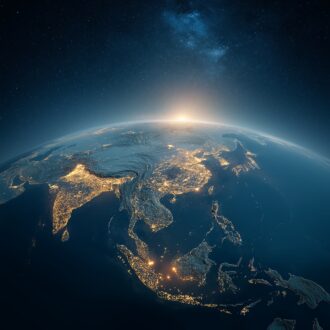Tsunamis are one of the most devastating natural disasters in the world. The name comes from the Japanese word “tsunami” or “ocean wave.” A tsunami is a series of waves caused by an earthquake. The first wave is called a low-frequency tsunami and travels at a slower speed than subsequent waves.
They’re caused by earthquakes and sea waves, which can cause massive damage. But can tsunamis be predicted? And what are some warning signs to look out for? We’ve got answers.
Yes, with some degree of accuracy. It’s not easy to predict tsunamis because they occur when a large amount of water is rapidly moved from one part of the ocean to another—and the earth’s crust is constantly in motion. So, predicting when one will happen isn’t something scientists can do yet, but they are working on it!
While tsunamis are not predictable, many warning signs can alert you to their presence. For example, a rumbling sound in the distance could be a precursor to an approaching tsunami. Also, if you see debris floating in the water or on land, this is another sign that a tsunami could strike your area soon. In addition to these signs, there are places where tsunamis do not occur—for example, deep underwater volcanoes where no waves can travel through them (although some have been known to cause landslides).
How Japan Has Tsunami-Proofed Its Territory
The recent disaster in Japan has shown us that tsunamis can be a devastating force of nature. However, there are ways to prepare for one’s arrival.
Japan is currently using technology to detect and prepare for an incoming tsunami. This includes using the internet to gather information about its location and size and using satellites to provide more accurate predictions of when one might occur.
But it’s not all bad news: scientists have been working to develop technologies that can help countries detect tsunamis before they strike and get ready to respond.
The technology works by creating a network of sensors that detect signs of an earthquake and send alerts to computers onshore or offshore, where they are analyzed by experts who can determine when and where a tsunami might occur.
With this information, authorities can prepare for the worst-case scenario by evacuating buildings or closing bridges. Some countries already have these systems up and running; others are just beginning their implementation.
What Are the Challenges?
The recent happenings have seen countries spend more on sophisticated international detection and warning systems. Scientists and disaster preparedness units can then spread such information through social media and mainstream media channels, including television and radio stations.
The challenge, however, is that in the Japanese Tsunami, the earthquake happens very close to the coast. The predicament only gives the authorities roughly up to ten minutes to warn the citizens and conduct evacuation protocols.
As a result, these countries, specifically Japan, have resorted to other methods to ensure that their citizens get timely information and know what to do with the data.
These methods include incorporating tsunami-related lessons in the school curriculum and putting up constant adverts on broadcast channels like radio and print media. The information here varies from the warning signs to the quickest escape routes to higher, safer grounds in cases of emergencies.
Evacuation
Japan has several highly populated towns along its coasts, which are not easy to evacuate on short notice. So, in the event of tsunamis, the authorities may need to direct the masses to the highest floors of the nearest building structures.
The Japanese government has prepared for this by testing all the vertical structures to determine which ones can accommodate people beyond the average height of a tsunami. On the same note, sensitive structures like nuclear structures are located far away from the shores and are designed to switch to safe mode when earthquakes are detected.
What Other Countries Are Doing
Besides Japan, several other countries, including the USA, Chile, and India, have experienced the devastating effect of the Tsunami. As such, they have put up structures and protocols, if not to tsunami-proof, at least to cushion themselves from the impact. Here is a sneak pick into what the most affected countries in the past decade are doing.
The United States
One area the US is scoring high is using stakeholders like the Red Cross to sensitize and prepare its masses for the impending risks of a Tsunami. Such organizations supplement government efforts by educating people on disaster preparedness and supporting casualties in cases of unfortunate events.
The country has a functional National Tsunami Warning Center (NTWC) and PTWS (established following the 1946 Aleutian Island earthquake and Tsunami). The United States has embraced technology to deal with this problem, including mobile apps to alert its people.
Chile
This American Nation has also been a casualty of tsunamis in the past. It has an advanced earthquake and tsunami warning system that uses Global Navigation Satellite Systems (GNSS) networks.
The TWS system assesses tsunami threats in under eight minutes. It gives data that the Servicio Hidrográfico y Oceanográfico de la Armada de Chile (SHOA) uses to communicate Tsunami early warning signs to the citizens through various media channels. Depending on their evaluation of the dangers, the authorities may choose to evacuate its people or have them stay put but alerted.
Australia
Australia is surrounded by the sea, a factor that increases its vulnerability to earthquakes and tsunamis. As such, the Australian Tsunami Warning System constantly collaborates with stakeholders like the Department of Home Affairs, Geoscience Australia (GA), and the Australian Bureau of Meteorology (BOM) to assess every possible threat.
The GA explicitly operates seismic stations countrywide and has access to data from global monitoring networks. It then uses its analysis to advise the BOM of the details, including the magnitude, characteristics, and location of seismic with the potential to produce a tsunami. Depending on this, the BOM collaborates with Home Affairs to spread the information to the Australian public.

Bottom Line
It is possible to design a tsunami prevention system. But it is difficult to say much more than this because of the uncertainty about the behavior of the Tsunami. We need more information. For example, we need to know how deep the fault is under an earthquake area, how close the fault is to the surface, and so on before we can design a prevention system.


